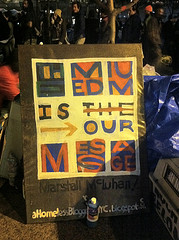This post by John Anderson originally appeared at DIYmedia.net and is republished here by permission.
Two decades ago, thousands of people took to the air without permission from the FCC to protest the agency’s draconian policies regarding access to the airwaves. The microradio movement conducted a campaign of electronic civil disobedience, demonstrating that there was plenty of space on the dial for community radio while illustrating just how enriching local access to the airwaves can be. The end result of this campaign was the creation of the LPFM service.Today, more than 10 years on from LPFM’s inception, unlicensed broadcasting remains alive and well, although the act is not as explicitly politicized as it once was.
This could change.
Last week, the Occupy Wall Street encampment established a microradio station at 107.1 FM. The station simulcasts the 24/7 live stream which provides coverage of life inside Zuccotti Park, as well as street-level reportage of daily protest actions in New York City’s financial district. The growth of the occupation has been impressive, and the establishment of a microradio station is another step in the action’s evolution.
One idea that’s been batted around involves integrating broadcasting into the occupation’s General Assembly, which functions as its governing body. City ordinances forbid the use of amplified sound systems in the park, which has resulted in the development of a “human microphone” system – speakers talk in sentence-fragments, which are repeated by the crowd so all can hear the dialogue. While it’s a very participatory method of group communication, it’s slow going and not necessarily scalable as the Assemblies grow.
In this instance, microradio could be employed to provide a non-amplified public address system – simply plug the speaker’s mic into a transmitter. Radios are cheap, and many smartphones have built-in FM reception capability. Some involved in the NYC action are brainstorming along these lines.
As more occupations are launched around the nation, their organizers have taken notes on how Occupy Wall Street has grown. Adding microradio to the tactical media mix makes lots of sense.
Radio still remains one of the most powerful tools of mass media available; one need look no further than the right-wing bastion of talk radio which has done so much to sully political discourse in this country. Microradio is easily accessible to a large audience and relatively uncomplicated to deploy. Unlike most other tools of protest-media, the critical infrastructure that makes radio work is pretty much self-contained, which adds to its reliability.
Microradio is also extremely useful as an outreach tool. The station in Zuccotti Park broadcasts to the occupation and immediate neighbors, which can be useful in the maintenance of good community relations. Microradio stations have been deployed in similar situations, such as festivals, farmer’s markets and picket lines, to extend the reach and impact of such events beyond their physical presence. In addition, opening up access to the airwaves in such a public manner helps to demystify the act of broadcasting and introduce folks to the notion that the airwaves, too, are a public space.
This leads to the final rationale for incorporating microradio into occupations – it’s an occupation of its own kind. One of the grievances expressed by Occupy Wall Street directly addresses corporate control of the media. There is no better way to address that grievance than by becoming the media directly, and unlicensed broadcasting has a long and storied history in the United States. Nothing signifies independent media quite like a microradio station.
Microradio is no more or less civilly disobedient than taking over and transforming a public space. Considering that the airwaves are ostensibly public property, they should be no less off limits in this context than a park or public right-of-way. Provided they do not interfere with other broadcasters, the addition of new signals to a local radio dial is materially non disruptive; what’s more, the FCC does not have police powers (and they also abhor confrontation).
Occupy Wall Street’s media team has been integral to sustaining the encampment, spreading the word, and inspiring others. New and future occupations are learning much from what’s happening in New York, where they’re heavily engaged in multi-platform citizen journalism, utilizing everything from the newest of new media forms to publishing their own newspaper and, of course, the human microphone. Microradio falls comfortably within this continuum and can help bootstrap more intensive media efforts.



